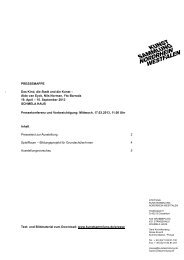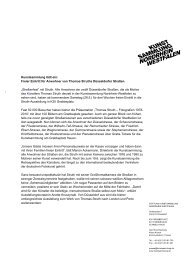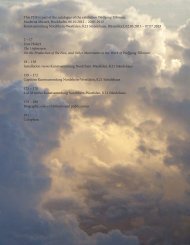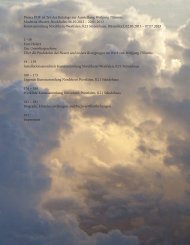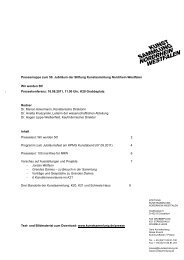Download online catalog (pdf)
Download online catalog (pdf)
Download online catalog (pdf)
Create successful ePaper yourself
Turn your PDF publications into a flip-book with our unique Google optimized e-Paper software.
Tom Holert<br />
The Unforeseen.<br />
On the Production of the New, and Other Movements in the Work of Wolfgang Tillmans<br />
Prelude: How a visitor may be led<br />
Warsaw, January 2012. Ascending the majestic staircase of the classicist art palace built<br />
between 1890 and 1900 for the Towarzystwo Zachęty Sztuk Pięknych, the then Society for<br />
the Encouragement of the Fine Arts, and now home to the Zachęta Naradowa Galeria Sztuki,<br />
Poland’s National Gallery, I make my way up to Wolfgang Tillmans’ exhibition Zachęta<br />
Ermutigung (Zachęta Encouragement). En route I see large paper-drop pictures hanging in<br />
niches that must originally have been intended for paintings. These close-ups of sheets of<br />
curling, curving photographic paper with shimmering and gleaming polychrome surfaces are<br />
unframed, held in position by the foldback clips that Tillmans uses to present his works on<br />
paper. With the three-dimensionality of the images and the three-dimensionality of the physical<br />
objects, the paper-drop pictures perform a dance of gravity, materials, reflections and shadows.<br />
They show what they are, even if not completely. For the difference between the materiality of<br />
the photographic paper ‘in’ the pictures and the archival sheets exhibited here (207 × 138 centimetres)<br />
that have absorbed the ink-jet prints, prevents any over-hasty identification.<br />
The brilliant white of the walls of this grand stairwell, the stage for real and imaginary<br />
art societies, forms a backdrop against which the white backgrounds of the paper-drop<br />
scenarios stand out discretely yet distinctly. Thus the opaque white of a classicist art ideal turned<br />
white cube contrasts with the white of an artistic project that is not beholden to any notion of<br />
an ideal white but that does nevertheless engage with an endless number of photographically<br />
producible white tones, with the grey tinges and marginal hues of a white that is never pure, that<br />
is always mixed, mingled, mashed.<br />
On the landing I turn to the right to continue my tour of the exhibition. I enter the first<br />
room, an airy gallery with a glass ceiling that indirectly allows daylight into the space. The pale<br />
parquet floor is empty – as opposed to the walls, which are loosely covered with works in all<br />
sorts of formats, some crowded together, some spaced far apart. That this part of the exhibition<br />
alone contains fifty-three pictures only dawns on me later on. For the abundance of exhibits is<br />
not overwhelming – if anything it evaporates, evanesces, ephemerates into the lightsome heights<br />
of the gallery, albeit not without forming hotspots, concentrated items and arrangements that<br />
require our concentration – combinations, groups, where gazes, gestures, lines, planes interact,<br />
where rhythms and chords arise and where the distinction between form and content is consistently<br />
rendered inoperative.<br />
I look straight ahead and see, on the wall facing me, two large, blue-black ink-jet prints<br />
from the Freischwimmer series, placed symmetrically side by side, at exactly the same height.<br />
Since it is impossible to miss this diptych from the entrance to the room, it sets the tone,<br />
establishing a benchmark for this display. The movements within the image in the left-hand<br />
Freischwimmer (187, 2011) run vertically; the dark, fibrous threads or cloud formations plunge<br />
downwards, or maybe stand up, whereas the right-hand picture (176, 2011) appears overall<br />
lighter and undulating, with dark hair tentacles flowing horizontally.<br />
The two Freischwimmer pictures are flanked on the same wall, at a respectable distance,<br />
by two smaller-format C-prints. On the far left is Genom (2002) and on the far right Nonkosi<br />
(2008): enlarged black-and-white photographs (printed on colour photo paper) of a still life<br />
with socks scattered on the wooden floor of a corridor in a domestic interior, and a half-length<br />
portrait of a woman against a black background; leaning on her arms with her head turned<br />
towards the camera, she is wearing a red T-shirt with a logo that reads ‘HIV POSITIVE’.



